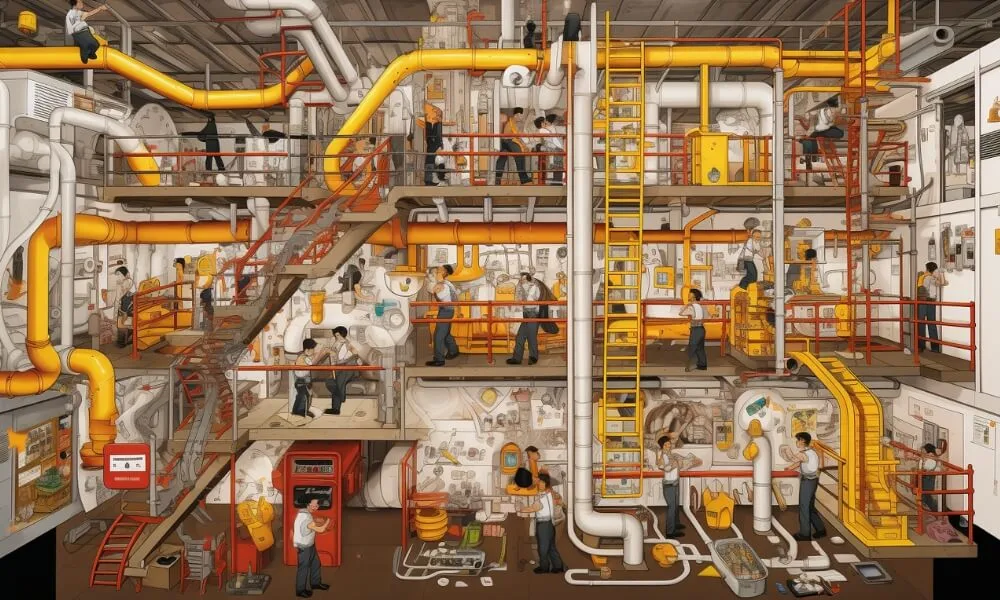Safety shortcuts, often defined as actions or decisions that bypass established safety protocols in favour of speed or convenience, can have dire consequences in the workplace. While they might seem like time-saving measures at the moment, these shortcuts can lead to accidents, injuries, and even fatalities. In the pursuit of efficiency, it’s crucial to remember that safety should never be compromised.
In this blog, we will delve into 10 common workplace safety shortcuts, shedding light on the potential risks they pose and offering guidance on how to avoid them. By understanding and addressing these shortcuts, businesses can foster a safer work environment and protect their most valuable asset: their employees.
What is a Safety Shortcut?
A safety shortcut, in the context of the workplace, refers to any action or decision that bypasses established safety protocols or guidelines. While the primary motive behind taking shortcuts is often to save time or effort, it can inadvertently compromise safety, leading to potential accidents or injuries. Taking safety shortcuts in the workplace can be extremely dangerous and have serious consequences.
These shortcuts may involve skipping steps in a process, using improper tools or equipment, or neglecting to wear personal protective equipment (PPE). Regardless of the specific shortcut, the underlying factor is that established safety procedures are being ignored or disregarded.

Why Do Workers Take Shortcuts at Work?
Workers often take shortcuts at work for a variety of reasons. Understanding these reasons can help employers and managers develop strategies to reduce the occurrence of shortcuts, especially when they compromise safety or quality. Here are some common reasons why workers might take shortcuts:
To address the issue of workers taking shortcuts, employers need to foster a culture of safety and open communication. Regular training, clear communication of expectations, and consistent supervision can go a long way in ensuring that workers follow established procedures and prioritize safety over speed.

10 Workplace Safety Shortcuts and How To Avoid Them
In the quest for efficiency and productivity, shortcuts often seem appealing. However, in the context of workplace safety, these shortcuts can lead to significant risks. Here’s a breakdown of ten common workplace safety shortcuts and the potential dangers they pose:
1. Skipping Safety Equipment (PPE)
Many workers take shortcuts by not wearing the proper safety equipment, such as safety glasses or gloves. This is often done to save time or because the equipment is uncomfortable. However, neglecting to use PPE can lead to accidents or injury.
How to Avoid This Shortcut:
- Always ensure that safety equipment is available and in good condition.
- Develop a safety culture where using PPE is a common practice and workers are encouraged to always take the time to wear it.
2. Ignoring Safety Signs and Labels
Safety signs and using safety labels are an important part of workplace safety. When workers ignore or find them difficult to read, many things can be missed, increasing the risk of accidents.
How to Avoid This Shortcut:
- Ensure that safety signs are clear, visible, and placed in relevant work areas.
- Conduct regular safety training sessions and toolbox talks to emphasize the importance of heeding safety signs.
3. Bypassing Safety Procedures
In the rush to get work tasks completed, workers might skip certain safety procedures, thinking it will get the job done faster. This dangerous shortcut can lead to incidents as well as injuries.
How to Avoid This Shortcut:
- Set the expectation for workers to follow all safety procedures, no matter how minor they seem.
- Regularly review and update safety policies to ensure they are relevant and effective.
4. Not Taking Breaks
Rushing during tasks and not taking breaks can lead to fatigue, making mistakes more likely. It’s a common safety shortcut that can have dire consequences.
How to Avoid This Shortcut:
- Encourage workers to take regular breaks as a way to relax and refresh.
- Monitor work schedules to ensure they allow for adequate rest periods.
5. Using the Wrong Tools for the Job
To save time, workers might use whatever tool is at hand, even if it’s not the right one for the job. This can cause damage to materials, the tool itself, and even injure the worker.
How to Avoid This Shortcut:
- Ensure that the correct tools are available and easily accessible.
- Provide training on the proper use of tools and the dangers of using the wrong ones.
6. Overlooking OSHA Regulations
Ignoring OSHA regulations is a dangerous shortcut that can lead to unsafe working conditions and increase risk exposure for workers.
How to Avoid This Shortcut:
- Stay updated on OSHA regulation changes and ensure compliance in the workplace.
- Conduct regular safety meetings and toolbox talks to discuss and reinforce OSHA guidelines.
7. Not Reporting Hazards
When workers notice a hazard but don’t report it, they’re taking a safety shortcut that can lead to accidents.
How to Avoid This Shortcut:
- Create an open communication environment where workers feel comfortable reporting hazards.
- Address and rectify reported hazards promptly.
8. Inadequate Training for New Hires
When a company hires someone and doesn’t provide adequate safety training, they’re taking a shortcut that can lead to accidents.
How to Avoid This Shortcut:
- Ensure that all new employees are given comprehensive safety training.
- Regularly update training materials to reflect current safety standards and practices.
9. Self-Imposed Pressure to Rush Tasks
Sometimes, individuals put pressure on themselves to perform a task faster, even if there’s no real outside pressure to get a work task completed quickly. This can lead to mistakes and accidents.
How to Avoid This Shortcut:
- Encourage a work culture where quality is prioritized over speed.
- Provide support and resources to help workers manage their time effectively.
10. Ignoring Regular Safety Inspections
Avoiding safety inspections is a shortcut that can overlook potential hazards, leading to accidents.
How to Avoid This Shortcut:
- Schedule regular safety inspections and ensure they are thorough.
- Address any issues found during inspections promptly.

Potential Injuries from Taking Dangerous Shortcuts
Taking dangerous shortcuts at work can lead to a wide range of injuries, some of which can be severe or even fatal. The specific injuries depend on the nature of the job and the type of shortcut taken. Here are some potential injuries that can result from taking dangerous shortcuts:
Employers and workers must realize that shortcuts, especially those that bypass safety protocols, can have dire consequences. Proper training, regular safety reminders, and fostering a culture of safety can help reduce the risk of these injuries.

The Role of Toolbox Talks in Preventing Workplace Safety Shortcuts
Toolbox talks are informal safety meetings that focus on specific safety issues related to the day’s work. These talks play a pivotal role in preventing workplace safety shortcuts, and here’s how:
- Raising Awareness: By discussing specific hazards and risks associated with tasks, toolbox talks make workers more aware of potential dangers. When workers are informed about the risks, they are less likely to take shortcuts that could expose them to those hazards.
- Reinforcing Safety Protocols: Regularly discussing and revisiting safety procedures ensures that they remain fresh in workers’ minds. This constant reinforcement makes it more likely that workers will adhere to these protocols instead of looking for quicker, riskier alternatives.
- Encouraging Open Communication: Toolbox talks provide a platform for workers to voice their concerns, ask questions, or share experiences. When workers feel heard and can discuss the challenges they face, they are less likely to resort to unsafe shortcuts out of frustration or uncertainty.
- Highlighting Real-life Incidents: Discussing recent accidents or near-misses during toolbox talks serves as a stark reminder of the consequences of neglecting safety. By understanding the real-world implications of taking shortcuts, workers are more likely to prioritize safety.
- Promoting a Safety Culture: Regular toolbox talks emphasize the company’s commitment to safety. When safety is ingrained in the workplace culture, workers are less inclined to take shortcuts that could compromise their well-being or that of their colleagues.
- Providing Task-specific Guidance: Toolbox talks can be tailored to address the specific tasks or challenges of the day. By offering guidance that’s directly relevant to what workers will be doing, these talks reduce the temptation to take shortcuts due to uncertainty or lack of knowledge.
- Identifying and Addressing Common Shortcuts: Toolbox talks can be used to discuss common shortcuts that workers might be tempted to take and explain why they are dangerous. By directly addressing these shortcuts, workers are forewarned and better equipped to avoid them.
- Building Team Accountability: When safety topics are discussed openly in a group setting, it fosters a sense of collective responsibility. Workers are more likely to hold each other accountable and discourage peers from taking dangerous shortcuts.
- Offering Solutions to Challenges: If workers are taking shortcuts due to specific challenges or obstacles, toolbox talks can be a platform to discuss and find safer alternatives or solutions.
- Continuous Learning and Adaptation: The regularity of toolbox talks ensures that safety learning is ongoing. As new risks emerge or as tasks change, these talks adapt, ensuring that workers are always equipped with the latest safety knowledge, reducing the allure of shortcuts.
In conclusion, toolbox talks serve as a proactive approach to workplace safety. By addressing issues head-on, fostering open communication, and continuously reinforcing the importance of safety; these talks play a crucial role in preventing workers from resorting to potentially harmful shortcuts.

Avoiding Safety Shortcuts: Best Practices
Avoiding safety shortcuts is crucial for maintaining a safe work environment. Here are some best practices to ensure that safety isn’t compromised in the pursuit of efficiency or convenience:
By implementing these best practices, organizations can significantly reduce the likelihood of employees taking safety shortcuts, ensuring a safer work environment for everyone.
OSHA and Workplace Safety Shortcuts
The Occupational Safety and Health Administration (OSHA) plays a pivotal role in ensuring safe working conditions in the U.S. Central to OSHA’s mission is the General Duty Clause, which mandates employers to provide a hazard-free workplace. This inherently discourages workplace shortcuts, as such actions can introduce recognized hazards.
OSHA emphasizes the importance of proper training and the correct use of Personal Protective Equipment (PPE). For instance, bypassing established lockout/tagout procedures or neglecting PPE can lead to severe injuries. Through its regulations, OSHA aims to eliminate the inclination for workers to take shortcuts, ensuring safety remains paramount.
Conclusion
In the realm of workplace safety, shortcuts are a risky gamble that can jeopardize both employee well-being and organizational integrity. While the allure of saving time or simplifying tasks might seem appealing, the potential costs—both human and financial—are far too great.
As we’ve explored in this blog, understanding the common safety shortcuts and their implications is the first step. Implementing proactive measures, fostering a culture of safety, and ensuring continuous education are paramount. Remember, a momentary lapse in safety can have lasting consequences. Prioritize safety always; it’s an investment that pays immeasurable dividends in the form of protected lives and a thriving workplace.

